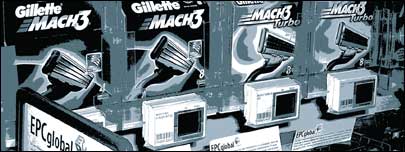Procter & Gamble (P&G) told RFID Journal that the “validation work” it was doing with Wal-Mart to determine whether EPC RFID could be used to improve promotions execution was finished, so there was no reason to continue tagging. A company spokesperson also said: “The use of EPC requires deep levels of collaboration between the manufacturer and the retailer, and a commitment to use the actionable visibility provided by the EPC to change business processes.”
Reading between the lines, it appears P&G was unhappy that Wal-Mart was asking it not only to tag the displays but also to hire merchandisers to go into the stores and alert Wal-Mart associates to put the displays out if they were still in the back room. The feeling at P&G seems to be that if Wal-Mart wants the supplier to pay for the tags, then it should act on the data the tags provide and have its associates get the promotional displays on the floor.
RFID Journal’s interpretation is that the $84 billion consumer packaged goods company was telling the $400 billion retailer that it wouldn’t absorb the cost of the tags if Wal-Mart wasn’t going to take action that would enable both companies to benefit.
There were different interpretations, though no one wanted to go on the record when sharing them with RFID Journal. One person at P&G said the tagging of displays was a separate project with separate funding, and when the initial budget was expended, it was not renewed, so tagging had to be halted.
One CPG company that competes with P&G saw this as a sign that Wal-Mart was backing away from its EPC RFID efforts. P&G would not have done this without Wal-Mart’s OK, the thinking goes. And this, therefore, was a tacit sign from Wal-Mart that it would not be using EPC RFID data to improve promotions management.
An executive at another CPG company said he didn’t know what it meant, but was concerned about the implications for EPC RFID adoption and his company’s own efforts to use the technology. “I know I’m going to be asked some tough questions [by senior management] about why we’re tagging promotional displays when P&G isn’t.”
But an executive at an RFID technology company cautions against reading too much into P&G’s decision. “These are two very big companies, and they have a long history of both collaborating and antagonizing one another,” he says. “This is part of an ongoing game they play.”
The decision by P&G will be a setback for EPC RFID adoption if other CPG companies decide to stop tagging promotional displays as well. It could be a positive, however, if Wal-Mart reacts by becoming more proactive in responding when data indicates that displays intended for the retail sales floor are in the back room.
Either way, the impact on companies that provide EPC RFID technology will be minimal. The volume of tags currently used for tracking promotional displays is small, and most RFID vendors are working with CPG suppliers and companies in other industries on closed-loop applications, such as asset tracking within an enterprise’s four walls.


